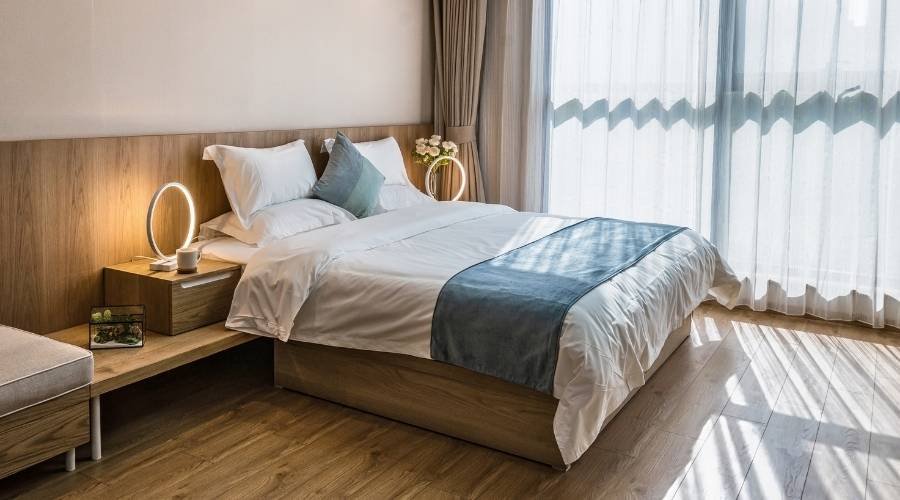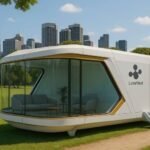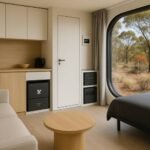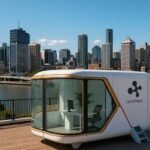Understanding Modular Homes
Let’s chat about modular homes and what makes ’em different from the old-school houses we see all over the place, and why they can be a game-changer for folks, families, and even businesses.
Modular Homes vs Traditional Homes
So, when we stack modular homes against their traditional buddies, a few things matter—like cost, how long they take to throw up, and how good they are. You’re looking at modular homes costing around AU$ 3,800 to AU$ 4,800 for each square metre. On the other hand, the traditional stick houses hit you between AU$ 3,0000 and AU$ 5,400 per square metre.
| Home Type | Cost per Square Metre (AU$) |
|---|---|
| Modular Homes | 3,800 – 4,800 |
| Traditional Homes | 3,000 – 5,400 |
These days, the price of a new stand-alone home down under is up by almost 20% thanks to fewer skilled workers and materials. So, going the regular build route might not be as tempting as it used to be.

Benefits of Modular Homes
Modular digs come with a bunch of perks that make them cool alternatives. They’re put together off-site, so you’re cutting building time in half, which means shelling out less for workers. From what we’ve seen, this speed means you can settle in real quick, getting families comfy sooner rather than later.
Big benefits include:
- Quality and Precision: Built in factories where they’ve got hawk eyes on quality, these homes often turn out snazzier than their traditional peers.
- Eco-Friendly: The green folk love these since they’re made to save energy and waste way less than the regular builds.
- Breath of Fresh Air: They come equipped with great ventilation and non-toxic materials, keeping the air indoors fresh and clean.
- Made to Last: Modular homes are built to hang tough, matching and sometimes beating traditional homes for durability.
We reckon you should check out what’s on offer in transportable homes NSW, relocatable homes NSW, and portable homes NSW to see what fits your style and needs. And for a bit more room, transportable granny flats NSW are worth a look—they’re flexible and comfy, just what a growing family might need.
Cost Considerations
When we think about building that dream pad of ours, let’s get real: money talks! Modular homes in NSW might just be the budget-friendly twist to the classic home game, offering a sweet mix of savings and good stuff.
Cost Comparison with Stick-Built Homes
Now, let’s get down to brass tacks about cost. Modular homes can hold their own against the old-school stick-built ones. Industry whispers say that a snazzy modular home from a crew like Modscape will run us between AU$3,800 and AU$4,800 per square metre. Meanwhile, building a traditional stick-built joint might set us back anywhere from AU$ 3,000 to AU$ 5,400 per square metre.
| Home Type | Cost per Square Metre (AU$) |
|---|---|
| Modular Homes | 3,800 – 4,800 |
| Traditional Stick-Built Homes | 3,000 – 5,400 |
Sure, modular homes don’t always come in cheaper than the low-end stick-built ones, but they can bring great bang-for-buck, especially if we’re craving some quality digs. It’s wise to have a chinwag with builders, chew over our budget, and pin down what works for us. If we’re curious about more options, let’s scope out transportable homes in NSW.
Reduction in Labour Costs
The beauty of modular homes? Less cash spent on worker bees! With prefab construction, we’re looking at cutting project time in half, which means big-time savings on labour costs compared to traditional homes.
When those prefab parts roll up, they’re ready to go. Keeps the worker count low on-site. This setup? It trims costs and dodges those pesky delays that tend to pop up.
Oh, and let’s not forget, modular building could chop wastage down by a hefty 90% compared to the old ways. Inside the factory lines, everything’s measured and managed just right, leaving hardly any materials for the bin. That’s a bonus for our wallets and a high-five for Mother Earth!
As we mull over modular homes, it’s clear the dough saved and green perks are worth a think. We ought to size up all options, like the kind of modular setup that’ll groove best with our lifestyle. Still hungry for more choices? Check out relocatable homes NSW or portable homes NSW for fresh ideas.
Sustainable Design Features
We’re all about putting together cosy, private, and affordable homes while keeping our planet in mind. Building modular homes in NSW isn’t just another trend—it’s a smart way to live sustainably, pleasing both the people in the houses and Mother Nature herself.
Sustainable Materials Used
Let’s get into the nuts and bolts. Building our modular homes, we’re super picky with materials, aiming to leave a smaller carbon footprint. Here’s a sneak peek at some green choices:
| Sustainable Material | What It’s All About |
|---|---|
| Reclaimed Wood | Breathing new life into old buildings or furniture. |
| Recycled Steel | Keeps the steel demand down and gives old metal a new purpose. |
| Low-VOC Paints | Less of the nasty stuff—those volatile organic compounds. |
| Bamboo Flooring | Grows faster than you clean your dishes—a fav renewable pick. |
Using materials like these not only green the build green but also improves indoor air quality. Pair these with toys like non-toxic products and top-notch air systems, and you’re breathing easy in a place that’s both fresh and pollutant-free.
Green Building Techniques
Building a modular home with green tricks up its sleeve is the modern thing to do. It’s all about saving energy and going easy on the planet, and here’s how we do that:
- Precision Construction: Imagine crafting your home in a Lego-kit-like setup. Less mess, perfect fitting parts, and voila—less waste!
- Better Insulation: Think of wrapping your home in a snug, thermal blanket. It keeps the temperature where you want it, without guzzling energy.
- Natural Light Optimization: Big windows, smart designs—letting in more sun saves on flicking switches.
- Passive Solar Heating and Cooling: It’s a bit of a sun dance—using window spots and thermal walls, the weather fills in as your heating and cooling buddy, cutting down on the energy bill.
These eco-friendly tweaks not only slash your energy costs but also do their bit in making less trash. Considering a dive into transportable homes in NSW? Or pondering relocatable homes in NSW? Whatever the twist, picking modular homes is the savvy choice for green living.
Notable Modular Home Builders in NSW
When it comes to modular homes in NSW, it pays to know who’s doing it right. Here’s a spotlight on the top builders leading the charge in quality, sustainability, and innovation:
Lunarnest
Where smart design meets sustainable living.
Lunarnest leads the way in offering flexible, future-ready modular homes that are as stylish as they are practical. Whether you’re looking for a compact retreat or a full-size family home, Lunarnest homes are designed with adaptability, affordability, and eco-consciousness at their core.
Why choose Lunarnest?
-
🛠️ Customisable layouts to fit evolving needs
-
⚡ Fast, efficient off-site construction
-
🌱 Sustainable materials and passive solar design
-
💰 Competitive pricing without sacrificing quality
-
📱 Optional smart tech and energy-efficient systems
With Lunarnest, you’re not just buying a home—you’re investing in a lifestyle that’s modern, mindful, and made to last.

Strine Environments
Based in Queanbeyan, NSW, Strine Environments is the cool kid on the modular block, known for its dedication to green design. They’re all about crafting homes that fit like a glove in their surroundings without messing up the planet. If you’re into earth-friendly living, their trailblazing designs are sure to catch your eye.
Valley Workshop
Valley Workshop is all about brainy architecture with a heart for conservation. They’re the real deal for energy-saving modular homes, making sure you get a home that’s not just a pretty face but also gives a high-five to the environment. Their focus on eco-friendly building practices makes them a solid choice in the modular homes scene.
Maap House
Operating out of Buladelah, NSW, Maap House dishes up affordable and adaptable hybrid modular homes throughout Australia. They’re there for you if what you’re chasing is practicality without cutting corners on quality. With designs that fit a variety of needs, they offer a flexible option in the modular homes arena.
Habitech Systems
From their HQ in Sydney, Habitech Systems rolls out wallet-friendly housing across various states, including NSW. They’re recognized for their fresh take on design and making homes with spaces that just work. Offering affordable homes without dropping the ball on style or comfort is what they do best.
Modscape
Another powerhouse in Australia’s prefab game, Modscape marries good looks with functionality. Catering to a bunch of different tastes and needs, their designs ensure each home feels like it’s made just for you. Their knack for detail and innovative building technology puts them at the forefront of modular home options.
Ecoshelta
Camped out in Rozelle, NSW, Ecoshelta brings to the table modular tough pods and easy-to-install e-pods. These homes can be shifted and set up in a jiffy, showing off their flair for fast and hassle-free solutions. With a focus on durability, these homes are built to brave the elements, fitting nicely into a range of climates.
Checking out these builders makes it easier to find modular and transportable homes that fit the bill. Each company puts its spin on modular building, making sure there’s no shortage of choices for families and individuals seeking cosy and eco-friendly living options. For more details on homes like these, visit our pages on transportable homes NSW, relocatable homes NSW, and portable homes NSW.
Customisation and Adaptability
When we dream of making a house a home, putting our stamp on it counts. Modular homes in NSW give us a chance to truly make our space our own, allowing us to tweak designs and create flexible areas that suit how we live.
Tailoring Home Designs
One of the coolest things about modular homes is just how adaptable they can be. We get to pick and choose layouts that match our style, whether it’s an extra bedroom for the kids or a spot for your side hustle. As life changes, so can our homes—no need for massive overhauls.
Because of how modular homes are built, changing up walls, rooms, or even whole floor layouts is a breeze. This means whether a new baby is on the way or we’ve just gone remote, our home can evolve right along with us without knocking down walls.
| Customisation Options | Examples |
|---|---|
| Floor Plans | Open plan, separate rooms, multi-storey |
| Room Sizes | Master suites, guest rooms, cosy offices |
| Exterior Finishes | Brick, timber cladding, sleek facades |
| Interior Styles | Modern, classic, minimalist |
Flexible Living Spaces
Modular homes really nail it with spaces that do more than one job. There are spots that can flip from a dining room to a play area or even a workspace. We can stay organised with furniture that pulls double duty, keeping things tidy and nice to look at, so the home is good for both guests and alone time.
These homes are ahead of the game, built with the latest techniques and materials that keep the energy bills down and the comfort high, no matter the season. Plus, using materials that are easy on the air we breathe means our homes feel good inside, too.
If you want to dive deeper into options for living spaces, take a peek at our line-up of transportable homes NSW, relocatable homes NSW, or even portable homes NSW. Considering a bit more room? Check out transportable granny flats NSW for just the thing.
Legal Regulations in NSW
Getting your head around the rules for modular homes in New South Wales (NSW) is a must if you want your new digs to fit nicely within the local dos and don’ts. Know the ropes so you can sidestep the usual headaches when checking out modular homes in NSW.
Planning Approval for Modular Homes
If you’re in NSW, you’ve got to play by the rules to put in a manufactured home or any prefab building. The Environmental Planning and Assessment Act 1979 steps in, saying these structures aren’t really ‘buildings’ while they’re still coming together, but you can’t just plop them down anywhere without a thumbs-up. This covers all homes with vital parts like kitchens, bathrooms, and living rooms.
Here’s the rundown:
- Submitting Applications: We’ve got to hand in applications showing the nitty-gritty details of the modular home we’re planning to park.
- Assessments: Your local council will put on its thinking cap and check if everything lines up with zoning laws and doesn’t wreak havoc on the environment.
- Community Consultation: Sometimes, we’ve got to chat with the neighbours about our blueprints.
Getting the green light means we can rest easy knowing our new home checks all the right boxes.
| Requirement | Notes |
|---|---|
| Planning Approval | You need it for plonking down the house, not putting it together. |
| Documentation Needed | Show the council exact plans for the modular house |
| Timeline for Approval | It’s a toss-up; it depends on your local council |
| Assessment Criteria | Zoning rules, impact on nature, and what the neighbours think |
Manufactured Home Estates
Recent tweaks to the Housing SEPP (State Environmental Planning Policy) in NSW have labeled the installation of two or more manufactured homes without shared facilities as a manufactured home estate. This means you can move in and divvy up space if the local plans give the nod for caravans.
So, what’s in it for us?
- Opportunities for Development: We can think about setting up a manufactured home estate to pitch in with affordable housing.
- Legal Clarity: These updates have untangled some legal knots around prefabs that used to trip up developers.
- Litigation History: Legal dust-ups like Ogilvie v Rovest Holdings Pty Ltd underscore why it’s important to toe the line.
Getting the go-ahead to set up multiple units in a manufactured home estate lets us give a nod to housing needs in NSW. Looking for more choices? Consider checking out relocatable homes in NSW and portable homes in NSW. Also, for those mulling over tight living spaces, transportable granny flats in NSW might just fit the bill.






